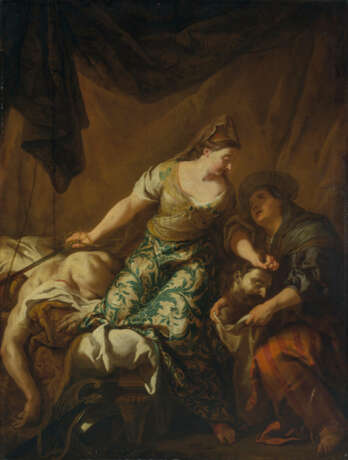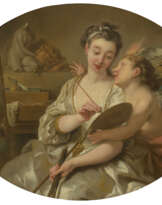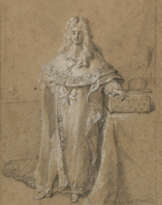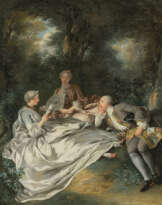ID 1071546
Lot 20 | JEAN-FRANÇOIS DE TROY (PARIS 1679-1752 ROME)
Valeur estimée
€ 100 000 – 150 000
Judith tenant la tête d’Holopherne
signé et daté 'DE TROY 1730' (en bas, vers la gauche, sur le pied du lit)
huile sur toile
195 x 147 cm. (76 ¾ x 57 7⁄8 in.)
Provenance
Denisot chez M. Bossu, rue Saint-Denis, Paris, en août 1782 (selon Annonces, Affiches et Avis divers, ou Journal Général de France, 14 août 1782, op. cit. infra).
Collection particulière, Italie.
Literature
Annonces, Affiches et Avis divers, ou Journal Général de France, 14 août 1782, 226, p. 1887 (comme '3 Tableaux de de Troy, de 6 pieds de haut sur 4,1⁄2 de large, représ. Esther & Assuérus, Dalila & Samson, Judith & Holopherne. S'adr. au nommé Denisot, chez M. Bossu, rue S. Denis, vis-à-vis la Trinité').
Annonces, Affiches et Avis divers, ou Journal Général de France, 29 novembre 1782, 333, p. 2751 (comme '3 beaux Tableaux de M. de Troy fils, l'un représ. Esther & Assuérus, l'autre Judith & Holopherne, et le 3e Samson et Dalila. Dem. 30, à 5h. rue Plâtriere, à l'hôtel de Bullion').
C. Leribault, Jean-François de Troy (1679-1752), Paris, 2002, p. 416, n°*P. 343 (comme 'perdu').
Further Details
JEAN-FRANÇOIS DE TROY, JUDITH HOLDING HOLOFERNES' HEAD, SIGNED AND DATED, OIL ON CANVAS
Previously, this imposing painting was only known to exist thanks to an advertisement of 1782, when it was for sale with M. Bossu, rue Saint-Denis, Paris, along with two other paintings by the painter. Its rediscovery adds a previously unseen subject to the work of Jean-François de Troy (1679-1752).
Taken from the Old Testament Book of Judith, the story of Judith and Holofernes recounts the fate of Holofernes, a Babylonian general who laid siege to the Jewish town of Bethulia because its inhabitants refused to support the war led by King Nebuchadnezzar II (627-265 BC). The town was on the verge of surrendering because the water supply was running out, but Judith, a ravishing young widow of considerable wealth, refused to give up. With her old maid, she entered the Babylonian camp one night. On seeing her, Holofernes immediately fell under the spell of her beauty and organised a feast in her honour, at the end of which he hoped to spend the night with her. However, when they were alone Judith to force him to drink, to the point where he was unable to defend himself; she then beheaded him and returned to Bethulia with his head. On discovering the death of their leader the next day, the Babylonian soldiers panicked and fled.
This story has inspired many artists over the centuries, and two key moments are the subject of almost all the paintings produced. The first is the beheading itself, with Judith's dramatic gesture as she plunges the sword into Holofernes' neck and the scarlet blood gushes from the fatal wound. Famous examples of this subject that can be cited are the painting by Caravaggio (1571-1610) in the Galleria Nazionale d'Arte Antica in Rome (inv. no. 2533) and the one by Artemisia Gentileschi (1593-1653) in the Uffizi (inv. no. 1890 n. 1567). The second moment in the story, and the one chosen by de Troy, corresponds to the moment when the triumphant Judith holds the head of the general in her hand. Less dramatic than the first, which requires tense muscles and a pool of blood, this moment is nonetheless the culmination of the drama and heralds her victory. In this instant Judith represents the triumph of the oppressed against tyranny, and in this case it is a singularly feminine triumph.
De Troy's treatment of the subject is in keeping with the French taste of the early 18th century. Here, Caravaggio's somber Baroque theatrics no longer have a place. This version is marked by the whimsical curves and asymmetrical lines of the Rococo style, with alternating fabrics and motifs, the stylised foliage on Judith's skirt and the stripes on that of her maid. Holofernes' mutilated body and head, with the sinuous lines of his muscles and hair, are camouflaged among the sheets. His blood is relegated to the very margins of the composition. This version of the triumph is notable for the absence of the brutality that is usually the epicentre of the painting. Instead, the artist presents us with a tender look, full of complicity between Judith and her old servant.
In de Troy's oeuvre we know of only two paintings that deal with the story of Judith and Holofernes, the present work and another that is still lost, whose existence is known to us thanks to the inventory of one Captain Filippo Palmieri written in Pisa in 1740. It is highly likely that the Palmieri painting dates from the artist's Pisan period, around 1704.
| Artiste: | Jean-François de Troy (1679 - 1752) |
|---|---|
| Technique appliquée: | Huile sur toile |
| Style artistique: | Vieux Maître |
| Lieu d'origine: | Europe de l'Ouest, France, Europe |
| Catégorie maison de vente aux enchères: | Peintures |
| Artiste: | Jean-François de Troy (1679 - 1752) |
|---|---|
| Technique appliquée: | Huile sur toile |
| Style artistique: | Vieux Maître |
| Lieu d'origine: | Europe de l'Ouest, France, Europe |
| Catégorie maison de vente aux enchères: | Peintures |
| Adresse de l'enchère |
CHRISTIE'S 9 Avenue Matignon 75008 Paris France | ||||||||||||||
|---|---|---|---|---|---|---|---|---|---|---|---|---|---|---|---|
| Aperçu |
| ||||||||||||||
| Téléphone | +33 (0)1 40 76 85 85 | ||||||||||||||
| Fax | +33 (0)1 40 76 85 86 | ||||||||||||||
| Conditions d'utilisation | Conditions d'utilisation | ||||||||||||||
| transport |
Service postal Service de messagerie ramassage par vous-même | ||||||||||||||
| Modes de paiement |
Virement bancaire | ||||||||||||||
| Heures d'ouverture | Heures d'ouverture
|








